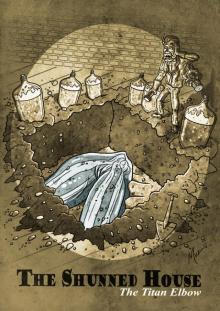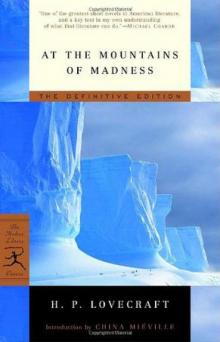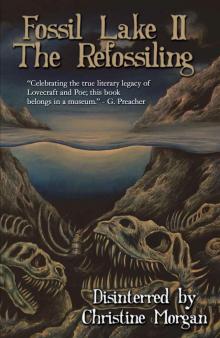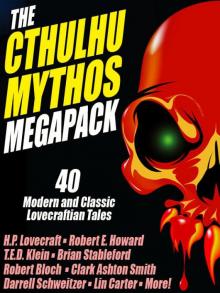- Home
- H. P. Lovecraft
At the mountains of madness Page 4
At the mountains of madness Read online
Page 4
On January 6, 1931, Lake, Pabodie, Daniels, all six of the students, four mechanics, and I flew directly over the south pole in two of the great planes, being forced down once by a sudden high wind which fortunately did not develop into a typical storm. This was, as the papers have stated, one of several observation flights; during others of which we tried to discern new topographical features in areas unreached by previous explorers. Our early flights were disappointing in this latter respect; though they afforded us some magnificent examples of the richly fantastic and deceptive mirages of the polar regions, of which our sea voyage had given us some brief foretastes. Distant mountains floated in the sky as enchanted cities, and often the whole white world would dissolve into a gold, silver, and scarlet land of Dunsanian dreams and adventurous expectancy under the magic of the low midnight sun. On cloudy days we had considerable trouble in flying, owing to the tendency of snowy earth and sky to merge into one mystical opalescent void with no visible horizon to mark the junction of the two.
At length we resolved to carry out our original plan of flying 500 miles eastward with all four exploring planes and establishing a fresh sub-base at a point which would probably be on the smaller continental division, as we mistakenly conceived it. Geological specimens obtained there would be desirable for purposes of comparison. Our health so far had remained excellent; lime-juice well offsetting the steady diet of tinned and salted food, and temperatures generally above zero enabling us to do without our thickest furs. It was now midsummer, and with haste and care we might be able to conclude work by March and avoid a tedious wintering through the long antarctic night. Several savage windstorms had burst upon us from the west, but we had escaped damage through the skill of Atwood in devising rudimentary aëroplane shelters and windbreaks of heavy snow blocks, and reinforcing the principal camp buildings with snow. Our good luck and efficiency had indeed been almost uncanny.
The outside world knew, of course, of our programme, and was told also of Lake’s strange and dogged insistence on a westward—or rather, northwestward—prospecting trip before our radical shift to the new base. It seems he had pondered a great deal, and with alarmingly radical daring, over that triangular striated marking in the slate; reading into it certain contradictions in Nature and geological period which whetted his curiosity to the utmost, and made him avid to sink more borings and blastings in the west-stretching formation to which the exhumed fragments evidently belonged. He was strangely convinced that the marking was the print of some bulky, unknown, and radically unclassifiable organism of considerably advanced evolution, notwithstanding that the rock which bore it was of so vastly ancient a date—Cambrian if not actually pre-Cambrian—as to preclude the probable existence not only of all highly evolved life, but of any life at all above the unicellular or at most the trilobite stage. These fragments, with their odd marking, must have been 500 million to a thousand million years old.
II
Popular imagination, I judge, responded actively to our wireless bulletins of Lake’s start northwestward into regions never trodden by human foot or penetrated by human imagination; though we did not mention his wild hopes of revolutionising the entire sciences of biology and geology. His preliminary sledging and boring journey of January 11–18 with Pabodie and five others—marred by the loss of two dogs in an upset when crossing one of the great pressure-ridges in the ice—had brought up more and more of the Archaean slate; and even I was interested by the singular profusion of evident fossil markings in that unbelievably ancient stratum. These markings, however, were of very primitive life-forms involving no great paradox except that any life-forms should occur in rock as definitely pre-Cambrian as this seemed to be; hence I still failed to see the good sense of Lake’s demand for an interlude in our time-saving programme—an interlude requiring the use of all four planes, many men, and the whole of the expedition’s mechanical apparatus. I did not, in the end, veto the plan; though I decided not to accompany the northwestward party despite Lake’s plea for my geological advice. While they were gone, I would remain at the base with Pabodie and five men and work out final plans for the eastward shift. In preparation for this transfer one of the planes had begun to move up a good gasoline supply from McMurdo Sound; but this could wait temporarily. I kept with me one sledge and nine dogs, since it is unwise to be at any time without possible transportation in an utterly tenantless world of aeon-long death.
Lake’s sub-expedition into the unknown, as everyone will recall, sent out its own reports from the short-wave transmitters on the planes; these being simultaneously picked up by our apparatus at the southern base and by the Arkham at McMurdo Sound, whence they were relayed to the outside world on wave-lengths up to fifty metres. The start was made January 22 at 4 a.m.; and the first wireless message we received came only two hours later, when Lake spoke of descending and starting a small-scale ice-melting and bore at a point some 300 miles away from us. Six hours after that a second and very excited message told of the frantic, beaver-like work whereby a shallow shaft had been sunk and blasted; culminating in the discovery of slate fragments with several markings approximately like the one which had caused the original puzzlement.
Three hours later a brief bulletin announced the resumption of the flight in the teeth of a raw and piercing gale; and when I despatched a message of protest against further hazards, Lake replied curtly that his new specimens made any hazard worth taking. I saw that his excitement had reached the point of mutiny, and that I could do nothing to check this headlong risk of the whole expedition’s success; but it was appalling to think of his plunging deeper and deeper into that treacherous and sinister white immensity of tempests and unfathomed mysteries which stretched off for some 1,500 miles to the half-known, half-suspected coast-line of Queen Mary and Knox Lands.
Then, in about an hour and a half more, came that doubly excited message from Lake’s moving plane which almost reversed my sentiments and made me wish I had accompanied the party.
“10:05 p.m. On the wing. After snowstorm, have spied mountain-range ahead higher than any hitherto seen. May equal Himalayas allowing for height of plateau. Probable Latitude 76° 15', Longitude 113° 10' E. Reaches far as can see to right and left. Suspicion of two smoking cones. All peaks black and bare of snow. Gale blowing off them impedes navigation.”
After that Pabodie, the men, and I hung breathlessly over the receiver. Thought of this titanic mountain rampart 700 miles away inflamed our deepest sense of adventure; and we rejoiced that our expedition, if not ourselves personally, had been its discoverers. In half an hour Lake called us again.
“Moulton’s plane forced down on plateau in foothills, but nobody hurt and perhaps can repair. Shall transfer essentials to other three for return or further moves if necessary, but no more heavy plane travel needed just now. Mountains surpass anything in imagination. Am going up scouting in Carroll’s plane, with all weight out. You can’t imagine anything like this. Highest peaks must go over 35,000 feet. Everest out of the running. Atwood to work out height with theodolite while Carroll and I go up. Probably wrong about cones, for formations look stratified. Possibly pre-Cambrian slate with other strata mixed in. Queer skyline effects—regular sections of cubes clinging to highest peaks. Whole thing marvellous in red-gold light of low sun. Like land of mystery in a dream or gateway to forbidden world of untrodden wonder. Wish you were here to study.”
Though it was technically sleeping-time, not one of us listeners thought for a moment of retiring. It must have been a good deal the same at McMurdo Sound, where the supply cache and the Arkham were also getting the messages; for Capt. Douglas gave out a call congratulating everybody on the important find, and Sherman, the cache operator, seconded his sentiments. We were sorry, of course, about the damaged aëroplane; but hoped it could be easily mended. Then, at 11 p.m., came another call from Lake.
“Up with Carroll over highest foothills. Don’t dare try really tall peaks in present weather, but shall later. Frightful work climbing, a
nd hard going at this altitude, but worth it. Great range fairly solid, hence can’t get any glimpses beyond. Main summits exceed Himalayas, and very queer. Range looks like pre-Cambrian slate, with plain signs of many other upheaved strata. Was wrong about volcanism. Goes farther in either direction than we can see. Swept clear of snow above about 21,000 feet. Odd formations on slopes of highest mountains. Great low square blocks with exactly vertical sides, and rectangular lines of low vertical ramparts, like the old Asian castles clinging to steep mountains in Roerich’s paintings. Impressive from distance. Flew close to some, and Carroll thought they were formed of smaller separate pieces, but that is probably weathering. Most edges crumbled and rounded off as if exposed to storms and climate changes for millions of years. Parts, especially upper parts, seem to be of lighter-coloured rock than any visible strata on slopes proper, hence an evidently crystalline origin. Close flying shews many cave-mouths, some unusually regular in outline, square or semicircular. You must come and investigate. Think I saw rampart squarely on top of one peak. Height seems about 30,000 to 35,000 feet. Am up 21,500 myself, in devilish gnawing cold. Wind whistles and pipes through passes and in and out of caves, but no flying danger so far.”
From then on for another half-hour Lake kept up a running fire of comment, and expressed his intention of climbing some of the peaks on foot. I replied that I would join him as soon as he could send a plane, and that Pabodie and I would work out the best gasoline plan—just where and how to concentrate our supply in view of the expedition’s altered character. Obviously, Lake’s boring operations, as well as his aëroplane activities, would need a great deal delivered for the new base which he was to establish at the foot of the mountains; and it was possible that the eastward flight might not be made after all this season. In connexion with this business I called Capt. Douglas and asked him to get as much as possible out of the ships and up the barrier with the single dog-team we had left there. A direct route across the unknown region between Lake and McMurdo Sound was what we really ought to establish.
Lake called me later to say that he had decided to let the camp stay where Moulton’s plane had been forced down, and where repairs had already progressed somewhat. The ice-sheet was very thin, with dark ground here and there visible, and he would sink some borings and blasts at that very point before making any sledge trips or climbing expeditions. He spoke of the ineffable majesty of the whole scene, and the queer state of his sensations at being in the lee of vast silent pinnacles whose ranks shot up like a wall reaching the sky at the world’s rim. Atwood’s theodolite observations had placed the height of the five tallest peaks at from 30,000 to 34,000 feet. The windswept nature of the terrain clearly disturbed Lake, for it argued the occasional existence of prodigious gales violent beyond anything we had so far encountered. His camp lay a little more than five miles from where the higher foothills abruptly rose. I could almost trace a note of subconscious alarm in his words—flashed across a glacial void of 700 miles—as he urged that we all hasten with the matter and get the strange new region disposed of as soon as possible. He was about to rest now, after a continuous day’s work of almost unparalleled speed, strenuousness, and results.
In the morning I had a three-cornered wireless talk with Lake and Capt. Douglas at their widely separated bases; and it was agreed that one of Lake’s planes would come to my base for Pabodie, the five men, and myself, as well as for all the fuel it could carry. The rest of the fuel question, depending on our decision about an easterly trip, could wait for a few days; since Lake had enough for immediate camp heat and borings. Eventually the old southern base ought to be restocked; but if we postponed the easterly trip we would not use it till the next summer, and meanwhile Lake must send a plane to explore a direct route between his new mountains and McMurdo Sound.
Pabodie and I prepared to close our base for a short or long period, as the case might be. If we wintered in the antarctic we would probably fly straight from Lake’s base to the Arkham without returning to this spot. Some of our conical tents had already been reinforced by blocks of hard snow, and now we decided to complete the job of making a permanent Esquimau village. Owing to a very liberal tent supply, Lake had with him all that his base would need even after our arrival. I wirelessed that Pabodie and I would be ready for the northwestward move after one day’s work and one night’s rest.
Our labours, however, were not very steady after 4 p.m.; for about that time Lake began sending in the most extraordinary and excited messages. His working day had started unpropitiously; since an aëroplane survey of the nearly exposed rock surfaces shewed an entire absence of those Archaean and primordial strata for which he was looking, and which formed so great a part of the colossal peaks that loomed up at a tantalising distance from the camp. Most of the rocks glimpsed were apparently Jurassic and Comanchian sandstones and Permian and Triassic schists, with now and then a glossy black outcropping suggesting a hard and slaty coal. This rather discouraged Lake, whose plans all hinged on unearthing specimens more than 500 million years older. It was clear to him that in order to recover the Archaean slate vein in which he had found the odd markings, he would have to make a long sledge trip from these foothills to the steep slopes of the gigantic mountains themselves.
He had resolved, nevertheless, to do some local boring as part of the expedition’s general programme; hence set up the drill and put five men to work with it while the rest finished settling the camp and repairing the damaged aëroplane. The softest visible rock—a sandstone about a quarter of a mile from the camp—had been chosen for the first sampling; and the drill made excellent progress without much supplementary blasting. It was about three hours afterward, following the first really heavy blast of the operation, that the shouting of the drill crew was heard; and that young Gedney—the acting foreman—rushed into the camp with the startling news.
They had struck a cave. Early in the boring the sandstone had given place to a vein of Comanchian limestone full of minute fossil cephalopods, corals, echini, and spirifera, and with occasional suggestions of siliceous sponges and marine vertebrate bones—the latter probably of teliosts, sharks, and ganoids. This in itself was important enough, as affording the first vertebrate fossils the expedition had yet secured; but when shortly afterward the drill-head dropped through the stratum into apparent vacancy, a wholly new and doubly intense wave of excitement spread among the excavators. A good-sized blast had laid open the subterrene secret; and now, through a jagged aperture perhaps five feet across and three feet thick, there yawned before the avid searchers a section of shallow limestone hollowing worn more than fifty million years ago by the trickling ground waters of a bygone tropic world.
The hollowed layer was not more than seven or eight feet deep, but extended off indefinitely in all directions and had a fresh, slightly moving air which suggested its membership in an extensive subterranean system. Its roof and floor were abundantly equipped with large stalactites and stalagmites, some of which met in columnar form; but important above all else was the vast deposit of shells and bones which in places nearly choked the passage. Washed down from unknown jungles of Mesozoic tree-ferns and fungi, and forests of Tertiary cycads, fan-palms, and primitive angiosperms, this osseous medley contained representatives of more Cretaceous, Eocene, and other animal species than the greatest palaeontologist could have counted or classified in a year. Molluscs, crustacean armour, fishes, amphibians, reptiles, birds, and early mammals—great and small, known and unknown. No wonder Gedney ran back to the camp shouting, and no wonder everyone else dropped work and rushed headlong through the biting cold to where the tall derrick marked a new-found gateway to secrets of inner earth and vanished aeons.
When Lake had satisfied the first keen edge of his curiosity he scribbled a message in his notebook and had young Moulton run back to the camp to despatch it by wireless. This was my first word of the discovery, and it told of the identification of early shells, bones of ganoids and placoderms, remnants of labyrinthodonts and
thecodonts, great mososaur skull fragments, dinosaur vertebrae and armour-plates, pterodactyl teeth and wing-bones, archaeopteryx debris, Miocene sharks’ teeth, primitive bird-skulls, and skulls, vertebrae, and other bones of archaic mammals such as palaeotheres, xiphodons, dinocerases, eohippi, oreodons, and titanotheres. There was nothing as recent as a mastodon, elephant, true camel, deer, or bovine animal; hence Lake concluded that the last deposits had occurred during the Oligocene age, and that the hollowed stratum had lain in its present dried, dead, and inaccessible state for at least thirty million years.
On the other hand, the prevalence of very early life-forms was singular in the highest degree. Though the limestone formation was, on the evidence of such typical imbedded fossils as ventriculites, positively and unmistakably Comanchian and not a particle earlier; the free fragments in the hollow space included a surprising proportion from organisms hitherto considered as peculiar to far older periods—even rudimentary fishes, molluscs, and corals as remote as the Silurian or Ordovician. The inevitable inference was that in this part of the world there had been a remarkable and unique degree of continuity between the life of over 300 million years ago and that of only thirty million years ago. How far this continuity had extended beyond the Oligocene age when the cavern was closed, was of course past all speculation. In any event, the coming of the frightful ice in the Pleistocene some 500,000 years ago—a mere yesterday as compared with the age of this cavity—must have put an end to any of the primal forms which had locally managed to outlive their common terms.

 The Best of H.P. Lovecraft
The Best of H.P. Lovecraft The Definitive H.P. Lovecraft: 67 Tales Of Horror In One Volume
The Definitive H.P. Lovecraft: 67 Tales Of Horror In One Volume The Complete Works of H.P. Lovecraft
The Complete Works of H.P. Lovecraft Other Gods and More Unearthly Tales
Other Gods and More Unearthly Tales Lovecraft's Fiction Volume I, 1905-1925
Lovecraft's Fiction Volume I, 1905-1925 The Shadow Out of Time
The Shadow Out of Time The Shunned House
The Shunned House Lovecraft's Fiction Volume II, 1926-1928
Lovecraft's Fiction Volume II, 1926-1928 The Thing on the Doorstep and Other Weird Stories
The Thing on the Doorstep and Other Weird Stories Dream Cycle of H. P. Lovecraft: Dreams of Terror and Death
Dream Cycle of H. P. Lovecraft: Dreams of Terror and Death Great Tales of Horror
Great Tales of Horror Shadows of Death
Shadows of Death Delphi Complete Works of H. P. Lovecraft (Illustrated)
Delphi Complete Works of H. P. Lovecraft (Illustrated) Waking Up Screaming: Haunting Tales of Terror
Waking Up Screaming: Haunting Tales of Terror H.P. Lovecraft Goes to the Movies
H.P. Lovecraft Goes to the Movies The Road to Madness
The Road to Madness The Complete H.P. Lovecraft Reader (68 Stories)
The Complete H.P. Lovecraft Reader (68 Stories) The Horror in the Museum
The Horror in the Museum Collected Fiction Volume 1 (1905-1925): A Variorum Edition
Collected Fiction Volume 1 (1905-1925): A Variorum Edition Lovecrafts_Fiction, vol.I_1905-1925
Lovecrafts_Fiction, vol.I_1905-1925 Writings in the United Amateur, 1915-1922
Writings in the United Amateur, 1915-1922 H.P. Lovecraft: The Complete Works
H.P. Lovecraft: The Complete Works Collected Fiction Volume 3 (1931-1936): A Variorum Edition
Collected Fiction Volume 3 (1931-1936): A Variorum Edition H.P. Lovecraft: The Complete Fiction
H.P. Lovecraft: The Complete Fiction Collected Fiction Volume 2 (1926-1930): A Variorum Edition
Collected Fiction Volume 2 (1926-1930): A Variorum Edition Yog Sothothery - The Definitive H.P. Lovecraft Anthology
Yog Sothothery - The Definitive H.P. Lovecraft Anthology The Complete H.P. Lovecraft Collection (Xist Classics)
The Complete H.P. Lovecraft Collection (Xist Classics) The Watchers Out of Time
The Watchers Out of Time Eldritch Tales
Eldritch Tales The Other Gods And More Unearthly Tales
The Other Gods And More Unearthly Tales The New Annotated H. P. Lovecraft
The New Annotated H. P. Lovecraft At the mountains of madness
At the mountains of madness Bloodcurdling Tales of Horror and the Macabre
Bloodcurdling Tales of Horror and the Macabre Fossil Lake II: The Refossiling
Fossil Lake II: The Refossiling Shadows of Carcosa: Tales of Cosmic Horror by Lovecraft, Chambers, Machen, Poe, and Other Masters of the Weird
Shadows of Carcosa: Tales of Cosmic Horror by Lovecraft, Chambers, Machen, Poe, and Other Masters of the Weird H. P. Lovecraft
H. P. Lovecraft The Cthulhu Mythos Megapack
The Cthulhu Mythos Megapack The Complete H. P. Lovecraft Reader (2nd Edition)
The Complete H. P. Lovecraft Reader (2nd Edition) The Complete Fiction
The Complete Fiction Waking Up Screaming
Waking Up Screaming Transition of H. P. Lovecraft
Transition of H. P. Lovecraft![[1935] The Shadow Out of Time Read online](http://i1.bookreadfree.com/i2/04/12/1935_the_shadow_out_of_time_preview.jpg) [1935] The Shadow Out of Time
[1935] The Shadow Out of Time The Horror Megapack
The Horror Megapack